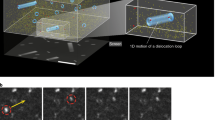Conclusions
This article has traced the concept of vacancy diffusion, starting with the Kirkendall effect through various stages to present universal acceptance as the preferred mechanism for impurity and self-diffusion for most metals and insulators. For pure metals we expect the activation energy for self-diffusion to be the sum of the energy for vacancy formation and the energy of motion but for impurity diffusion the temperature dependence of the correlation effect will make a contribution. Because of its large formation energy, the self-interstitial is not a thermal defect, but it does play a dominant role in the low-temperature annealing of radiation-damaged specimens. Large-scale computer calculations have been important in exploring both the process of displacement generation and the subsequent history of the interstitialcy as it moves in diffusion. In the guise of a crowdion the interstitial can be expected to have a long free path, but it is more stable in the dumbbell mode.
Similar content being viewed by others
References
A.D. Smigelskas and E.O. Kirkendal, Trans. AIME 171 (1947) p. 130.
N.F. Mott and M.J. Littleton, Trans. Faraday Society 34 (1938) p. 485.
H.B. Huntington and Frederick Seitz, Phys. Rev. 61 (1942) p. 315.
F. Fuchs, Proc. R. Soc. London 151 (1935) p. 585; 153 (1936) p. 622; 157 (1936) p. 444.
M. Born and J.E. Mayer, Z. Phys. 75 (1932) p. 1.
J. Steigman, W. Shockley, and F. Nix, Phys. Rev. 56 (1939) p. 13.
H.B. Huntington, Phys. Rev. 61 (1942) p. 326.
F.G. Fumi, Philos. Mag. 7th series 46 (1955) p. 1007.
C. Zener, Acta Crystallogr. 8 (1950) p. 346.
E.O. Kirkendall, Trans. AIME 147 (1942) p. 104.
I.C.C. DaSilva and R.F. Mehl, Trans. AIME 191 (1951) p. 155.
A. Nowick, Phys. Rev. 62 (1951) p. 551.
J.W. Kaufman and J.S. Koehler, Phys. Rev. 88 (1952) p. 149; 97 (1955) p. 555.
H.C. Gatos and A.D. Kurtz, J. Metals 6 (1954) p. 616.
R.D. Simmons and R.W. Balluffi, Phys. Rev. 117 (1960) p. 52; 119 (1960) p. 600.
R.D. Simmons and R.W. Balluffi, Phys. Rev. 119 (1960) p. 600 (1960).
R.D. Simmons and R.W. Balluffi, Phys. Rev. 117 (1960) p. 52.
R.D. Simmons and R.W. Balluffi, Phys. Rev. 125 (1962) p. 862.
R.D. Simmons and R.W. Balluffi, Phys. Rev. 129 (1963) p. 1533.
R. Feder and A.S. Nowick, Philos. Mag. 15 (1967) p. 805.
D. Lazarus, Phys. Rev. 93 (1954) p. 973.
A.D. Le Claire, Philos. Mag. 7 (1962) p. 141; 10 (1962) p. 641.
A.W. Overhauser, Phys. Rev. 90 (1953) p. 393.
A.D. Le Claire, Philos. Mag. 10 (1964) p. 641.
T.H. Blewett, R.R. Coltman, C.E. Klabunde, and T.S. Noggle, J. Appl. Phys. 28 (1957) p. 639.
H.G. Cooper, J.S. Koehler, and J.W. Marx, Phys. Rev. 94 (1954) p. 496; L. Phys. Rev. 97 (1955) p. 591.
C.J. Meecham and J.A. Brinkman, Phys. Rev. 103 (1954) p. 1193; A. Sosin and J.A. Brinkman, Phys. Rev. 120 (1960) p. 411.
J.W. Corbett, R.B. Smith, and R.M. Walker, Phys. Rev. 114 (1959) p. 1452, 1460.
H.B. Huntington, Phys. Rev. 9 (1953) p. 1092.
J.B. Gibson, A.K. Goland, M. Millgram, and G.H. Vineyard, Phys. Rev. 120 (1960) p. 1229.
T.H. Blewett, R.R. Coltman, C.E. Klabunde, and T.S. Noggle, J. Appl. Phys. 28 (1957) p. 639.
R.H. Silsbee, J. Appl. Phys. 28 (1957) p. 1246.
Rights and permissions
About this article
Cite this article
Huntington, H.B. Vacancies and Self-Interstitials. MRS Bulletin 16, 33–36 (1991). https://doi.org/10.1557/S0883769400055494
Published:
Issue Date:
DOI: https://doi.org/10.1557/S0883769400055494




